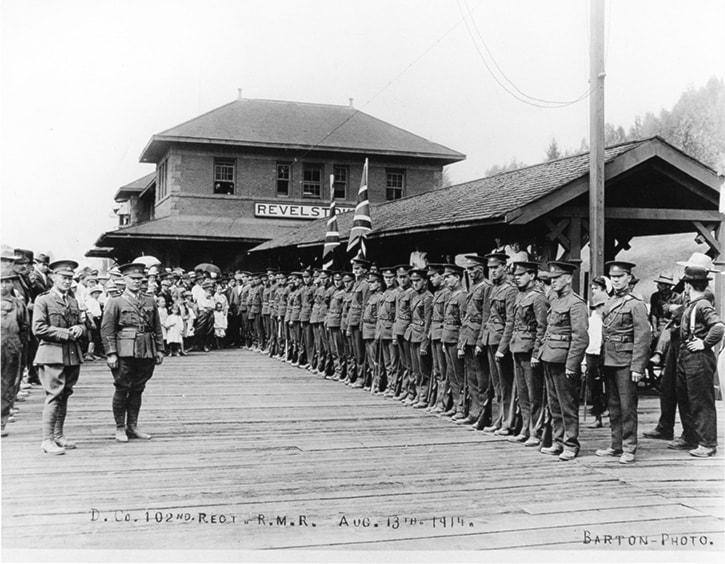August 4 marked 100 years since the United Kingdom declared war on Germany, bringing Canada along with it. In an ongoing series, the Times Review and the Revelstoke Museum & Archives will look at Revelstoke during WW1. We will look at the soldiers who went off to fight and the impact the war had on the community.
By Ken English, Revelstoke Museum & Archives
“Large crowds daily gather around the Mail-Herald bulletin boards where twice daily are posted the latest cable dispatches on the war situation.” This article from the August 5, 1914, issue of the Mail-Herald spoke of the outbreak of war. Throughout the years of conflict, the Mail-Herald and its newly-formed competitor, The Revelstoke Review would keep the local citizens apprised of war news.
The coming of war had been a topic of concern for the days preceding the announcement by Britain that it would join the conflict. The minister of the Revelstoke United Church, Reverend W. Lashley Hall, noted on Sunday evening August 1, that he had hoped that even at this late hour war could be averted. He mentioned that his congregation members “…could be proud of the part played by the British government during the prolonged crisis in trying to bring about an understanding. If need arose, in the hour of danger, we could with a clear conscience all stand together in the breach.”
The news of war was greeted with excitement and plans were begun for an immediate mobilization of volunteers from the Rocky Mountain Rangers, which had a company of militiamen here. After the South African campaign at the beginning of the century, citizen militias in Canada enjoyed a period of growth and enthusiasm. Our local drill hall (currently Trans-Canada Fitness) was built in 1902 to accommodate the growing number of young men who wished to experience the military life. These militias provided the first group of volunteers.
The volunteers had to be between the age of 18 and 45, at least 5 feet 3 inches tall, with a chest expansion of not less than 31.5”, skilled in musketry, and pass a physical examination by Dr. Hamilton, the local physician. By August 12 the Mail Herald recorded a list of 69 men who had answered the call of the King to the defense of the realm. Out of this first list of 69 men, 11 would not return to Canada. Numerous others on this list would be wounded.
The first duty of these volunteers was to guard the railway bridges east and west of town. Some were sent to Kamloops for training and from there deployment to Valcartier, Quebec, 16 miles northwest of Quebec City, the mobilization point for the first Canadian Contingent of volunteers. By Sept. 8, 100 special trains had brought in almost 33,000 volunteers. So many volunteers rushed to the colours that applications were cut off one week later. It was said that so many civil servants in Victoria were wishing to enlist that a tremendous strain was being put upon the already depleted workforce.
The Mail-Herald, in its August 29 edition, stated that 30 recruits from Revelstoke had been accepted into the First Contingent of Canadian troops to go to England. These recruits came to be known as the First Contingent. The September 2 edition of the Mail-Herald carried the story of the reception that this first contingent of Revelstoke volunteers received when they passed through Revelstoke on August 30 on their way to Valcartier.
The departure of all these men was a significant event for the community of Revelstoke. Throngs of people assembled at the train station to give a hearty farewell to the Revelstoke “boys.” All the students of Central and Selkirk Elementary Schools, and the high school massed together and saluted the arrival of the train with “hearty cheers and the waving of many flags.” The city band played and the civic guard was in attendance. There was much “…singing of patriotic songs…” and “…the roar of welcome from the crowd on the platform made a scene of animation and enthusiasm which will long be remembered by all those who witnessed it.”
The Revelstoke volunteers “disembarked from the train and marched in front of the children and gave hearty cheers for Revelstoke. Each man was presented by the Women’s Relief Society with a case containing socks, darning cotton, and other requisites. A box of Okanagan apples was also placed on the car. Many flowers and other gifts were made to the soldiers. Telegrams of thanks were sent back to town from points east, thanking the people of Revelstoke for their generosity. This particular sendoff was a very joyous occasion but later editions of the paper would note that sendoffs later in the war would note the teary eyes as the train left the station.
